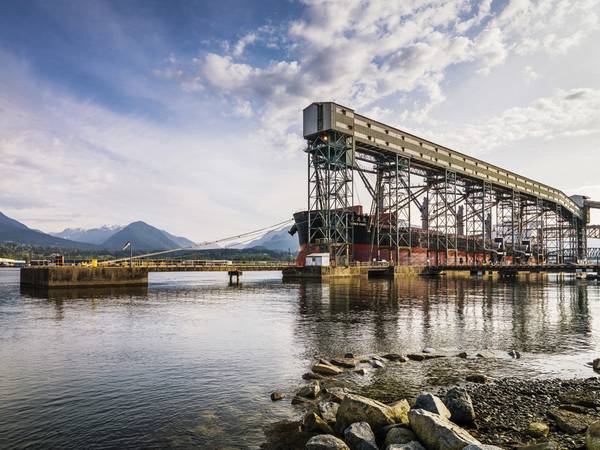Though overall cargo volume through the Port of Vancouver in 2016 decreased 1.8 percent to 136 million metric tons from 2015, sectors experiencing declines were offset by others that hit new records, including the bulk grain sector, according to the Vancouver Fraser Port Authority released its 2016 year-end statistics.
“One of our biggest strengths has been, and continues to be, the port’s ability to accommodate the most diversified range of cargo of any port in North America,” said Robin Silvester, president and chief executive officer of the Vancouver Fraser Port Authority. “Since 2013, the Port of Vancouver has experienced its fourth consecutive year of traffic volumes over 135-million-metric-tons, despite global economic downturns.”
The Port of Vancouver marked its third consecutive year of record volumes in bulk grain in 2016, its fifth year of an upward trend. Bulk grain export volumes through the port increased 1.3 percent from 2015, to reach 21.8 million metric tons in 2016. Strong global demand for Canadian agriculture was met with a bumper crop in Canada and increased exports of grain through the Port of Vancouver.
“The continued growth in grain volumes through the Port of Vancouver demonstrates the strong reputation of Canadian grain and reflects the expansion plans we are seeing for this commodity in particular,” Silvester said. “Demand for Canadian grain from many countries is being met by farmers across Canada and by terminals who continue to invest in new technology.”
Record bulk grain exports were driven by higher volumes of canola and specialty crop exports, which are up by 18.9 percent and 17.9 percent respectively. This growth was offset by a 16.4 percent decrease in wheat exports due to adverse weather conditions. The large increases in canola and specialty crops also offset decreases in thermal coal (down 28.2 percent). The port’s bulk dry cargo of 84.6 million metric tons represents a 2.9 percent decrease over 2015.
Containerized exports increased by 3.3 percent due to growth in woodpulp, grain and food and agri-product shipments. This increase was offset by a 2.4 percent decline in loaded import containers and a total container quantities decrease of 4.1 percent, partly due to the return of some traffic to U.S. west coast ports after their 2015 labor dispute, leading to a flat result in overall laden container volumes for 2016.
A weak Canadian dollar and a slowdown in industry investment and development activity in western Canada were reflected in the 17.2 percent decline in metal and project cargo imports in 2016. A 22 percent drop in breakbulk lumber and wood pulp also contributed to a decline in overall import and export breakbulk volumes. Breakbulk cargo declined by 1.4 percent, as a 3.8 percent increase in domestic traffic was more than offset by decreases in wood pulp (down 22.9 percent) and construction and materials (down 28.6 percent).
Metallurgical coal volumes increased 1.8 percent in 2016 due to a 64.3 percent increase in exports to India and sustained demand from Japan, China and South Korea. Overall coal volumes are down by 6.1 percent in 2016, due to a 28.2 percent decrease in thermal coal exports.
Bulk liquid tonnage was down by 2.2 percent over last year. The sharp decrease of 39.7 percent in crude petroleum exports is consistent with the fall in global oil prices. This is offset by increased gasoline volume of 16.2 percent, diesel and fuel oils (up 18.5 percent) and vegetable oil (up 13.4 percent).
Auto volumes increased by 2.3 percent compared to 2015, with 393,280 units moved through the port in 2016.
The cruise industry in Vancouver is experiencing stable growth as demand for Alaskan cruises continues to increase. In 2016, the port welcomed 228 cruise ships and 826,820 passengers compared to 805,400 passengers in 2015, an increase of three percent, as major cruise lines continue to invest in the Alaska itinerary.
Foreign vessel calls were slightly down in 2016 by 0.7 percent over 2015, with 3,105 calls.
“Thanks to the confidence that port users and terminal operators have shown in the Vancouver gateway, combined with our focus on infrastructure development and sustainability, the Port of Vancouver is well-positioned for continued growth.” Silvester said. “Investments are already underway to build capacity for this growth in multiple sectors.”
New Records for 2016 include:
- Total cargo shipped in containers at 25.1 million metric tons (MMT), slightly over the previous 2015 high of 25.0 MMT.
- Bulk grain at 21.8 MMT, up 1.3 percent over the previous 2015 high of 21.6 MMT.
- Canola at 7.1 MMT, 9.1 percent higher than the previous 2012 high of 6.5 MMT.
- Specialty crops, including pulses and lentils, at 4.2 MMT, 17.9 percent higher than the previous 2015 high of 3.5 MMT.
- Metallurgical coal at 26.2 MMT, slightly higher than the previous 2014 high of 26.1 MMT.
- Foreign gasoline at 1.4 MMT, 16.5 percent higher than the previous 2015 high of 1.2 MMT.
- Overall cargo traded through the Port of Vancouver declined in 2016, posting a 1.8 percent decrease in tonnage compared to 2015.




